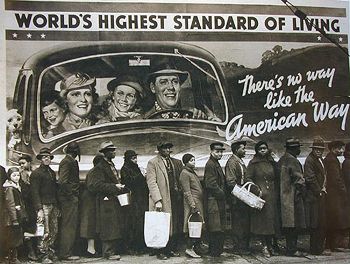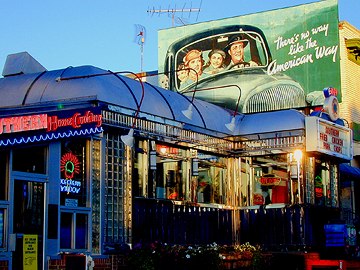
|
© Margaret
Bourke-White
|
"There is no way like the American Way"
by Pedro Meyer
|
|
I was driving recently down one of the beautiful avenues of Washington D.C. with a friend, when all of a sudden my eye caught a billboard above that archetype of Americana, a Diner. The interesting thing was that the sign I was looking at was a bit of Americana itself, a sign made ever so present in the 1937 picture by Margaret Bourke-White (MBW), created at the time of the Louisville flood. The billboard I am making reference to is "There is no way like the American Way". When I first saw it, all sorts of bells started to chime in my head about issues related to digital photography, obviously aside from all the social and political implications about the content of the image itself. I was struck by how fast we read meanings into an image, meanings which are beyond the information actually conveyed by the picture. In the case of the Louisville flood image by MBW, we see a queue of black people standing in line for something. We do not know what exactly they are waiting for. It could be all the way from waiting for transportation given the floods, or for food, or waiting for a doctor, like in any other nature related catastrophe to this very day. Because they are standing in line, and because they are black, we come to view them as being "poor". What emerges is an immediate association of those that are privileged (the white people in the car in the billboard) and the poor (the black people standing in line). But look again at the picture, and you will observe that most of those folks are actually very well attired and do not give off the impression of being "poor". They could, for all I know, be professionals and middle class, if not all, then at least some of them. I could even imagine some of those very same men in the line trading places with the white man behind the wheel of the car above. As you can observe one does not need digital manipulation to alter the meaning of a picture, we do a pretty good job ourselves with just "straight" pictures.
What impressed me is that I knew the billboard above the Diner from a photograph, and I immediately associated it with the Bourke-White image. I concluded right away that the present day billboard had to be a rip-off from that picture even though I had no evidence to support my speculation. Upon further introspection about this matter, I started to reconsider my judgment. First of all, the initial billboard, the one in MBW picture, and which in my eyes "makes" her picture, was like so much in our history of photography, an image which belonged intellectually and artistically to someone other than the photographer. MBW used that billboard in a very articulate manner, to make her "successful" picture, even though it did not "belong" artistically to her. It is only today, with so many debates going on about who has the copyright to what, and in particular under the jurisdiction of any alleged "digital rip-off", that such legal matters start to come to our attention. As a photographer these days if you would include within your picture frame such a large portion of an image of intellectual property belonging to someone else, as MBW did in hers, there would be all sorts of raised eyebrows to say the least. The original billboard is so much part of the Margaret Bourke-White picture, that I for one had, unwittingly I must add, handed over to her the intellectual property for that billboard. So much so, that when I saw it independently from her picture, I assumed right away that it had been "lifted" from her picture. For all I know this might have been the case, but even if this was so, that billboard still did not belong to her. So did she have a right to use it? Yes in 1937, I am not so sure in 1999, and that is something that concerns me greatly. As a working photographer I would hope that we would have the same freedom today that was prevalent then, but at the same time we have to contend with all sorts of additional issues of contemporary life related to photography (digital or not), which have not been addressed sufficiently. One could argue that the moment a sign is located on the street it becomes public domain. But is this really the case? I don’t think so, as I imagine advertising companies are very careful to defend such an issue in particular not to leave their creative efforts vulnerable to imitation. In Mexico for instance, we have the government intervening just as nefariously as the private sector corporations in the US, with their efforts of privatizing everything visual. I dare say they (the Mexican government) even took the model from the latter. To give you an example, the huge cultural heritage of all archeological sites that exist all over Mexico, instead of belonging to "the people" as it ought to be, are off limits to anyone wanting to photograph any of those places or pieces found in them. The argument that they use to impede photography, is that they are "protecting" whatever it is that they think they are guarding. However, as soon as you pay whatever sum they deem appropriate, those concerns vanish promptly. Imagine the French trying to regulate the imagery of the Eiffel tower, or the Statue of Liberty in the US. However that is what has happened in Mexico. You have to have a permit to photograph at any archeological site, and if you want to use your images for commercial use, you have to pay a hefty royalty fee. There is a certain logic behind trying to raise funds when the use is going to be commercial, but the argument is a very slippery one, as who has the rights to such intellectual property when you are dealing with public patrimony? This is not something that is discussed and regulated in an open forum with public disclosure. So when and how does a "public space" become public in the physical world? When does something become "public domain"? Where on the Internet is there a "public space" if any? Given the digital tools that we have today, one could well take any picture and place it within a "street image" as if it were a billboard and then show it publicly over the Internet, would that turn it into a "public domain" image? Do share your thoughts with us, on the content of this editorial. Let us know what you think about the public and private space as it relates to intellectual property. Let us know how you view the influence of digital photography upon these matters. In
closing let me wish all of you who have been with us here at ZoneZero
during these past five years, and all those who have just logged on
for the first time, the best for the upcoming millennium. May we continue
to enjoy each other's company with good health and plenty of love
for a long time to come.
|
For comments write to: pedro@zonezero.com
or post a message in our forum section at ZoneZero,
